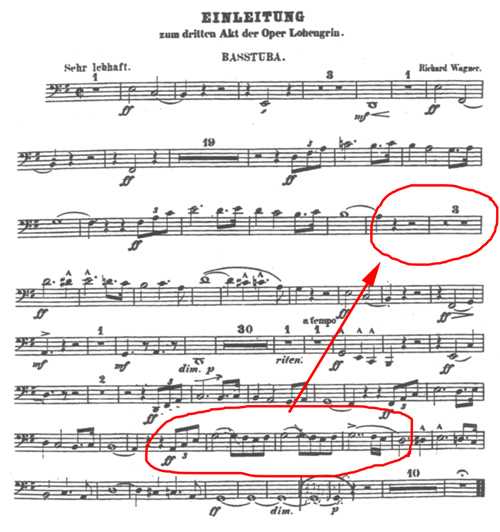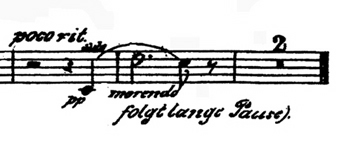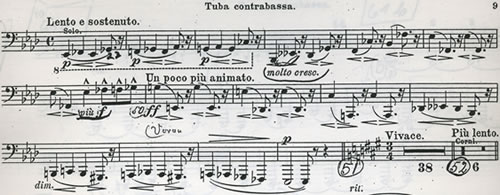Tradition and EvolutionWe have so much to be proud of when we look back over our short history; in just a few hundred years we have developed from the primitive serpent to the sophisticated instrument we have today, with wonderful repertoire, amazing improvements in instrument design, and virtuoso creative artists - this high velocity evolution seems to have no end in sight. Like religion, politics, arts, and technology, and in all aspects of life, we too have our liberals and our conservatives, those who choose to look to the future for new ideas and those who prefer to look back at our past structures and systems and try to maintain the established ways. In the mid 20th century there were two great conductors in the world who became the classical music standard bearers for these liberal and conservative views: Arturo Toscanini, the purist, who was absolutely faithful to the printed score and Leopold Stokowsky, who freely changed the score to what he thought would represent what the composer would have written if he had had the resources of the modern orchestra and/or the abilities of the modern player. In Tubadom (the world of the tuba) it's pretty much the same; we have our visionaries and we have our strict traditionalists. I will try not to suggest which of these philosophies I support other than to point out that in our very short history there are but few well-developed traditions that merit our consideration compared to what appears to be our brilliant future; sometimes I feel a little sorry for our strict traditionalists. Another great conductor of the past century, Eric Liensdorf, used to say that there were two kinds of tradition: magical musical moments that we try to repeat whenever possible and one hundred years of bad habits that we can't seem to correct! The essential question here is this: Is the symphony orchestra a sonic museum, which must adhere to the state of the art in the composers time and place of the world, or is it a living art work of sound structured on a canvas of time and realized by today's musicians in today's world? The tuba repertoire in the symphony orchestra is abundant with works that were written for both lesser-developed instruments and players than we have today. Had the magnificent instruments and the abundance of amazing virtuosos we have today been available then at the time much of our repertoire was composed, things probably would have been quite different. I would like to discuss examples from four master composers, of how I believe they might have treated their orchestrations regarding tuba if they had had today's resources. Berlioz: Symphonie PhantastiqueBerlioz did not write for the tuba, he wrote for the ophicleide, that last of our tuba ancestors before the emergence of the real tuba. The obsolete ophicleide at this moment is making a small comeback into the musical world, and particularly, I have seen one very interesting and charming televised performance of the Symphonie Phantastique not only using ophicleide but also using all the wind instruments from Berlioz's period. The key to the success of that performance is the fact that all the wind instruments were from the time of Berlioz. It's dubious, if only the ophicleide was used in an otherwise setting of modern instruments, the performance would have been as successful. Berlioz orchestrated the famous Dies Irae passage of the fifth movement, March to the Scaffold, for four bassoons on the low octave and two ophicleides on the top octave; this resulted in an appropriately earthy, raucous and well balanced sound. However, in modern orchestration, the four bassoons in the low octave, compared to two tubas in the upper octave, are usually inaudible. The correction is simple when the tubas play in octaves, with the lower tuba doubling the four bassoons. Most conductors, players, critics and listeners agree the results of this combination are both successful and effective. Wagner: Prelude to the Third Act of LohengrinA lesser known fact than Berlioz never having orchestrated for tuba, only ophicleide, is that the earlier operas of Wagner, specifically Rienzi, Flying Dutchman, and Lohengrin, were also originally orchestrated for ophicleide. As the ophicleide became more obsolete, Wagner began to write for the tuba and in agreement with his publisher he dropped ophicleide in the early works and in its place he specified tuba. It's very easy to see in these early operas a very clear similarity with the way Berloiz orchestrated for ophicleide. Mahler: First and Fifth SymphoniesThe famous tuba passage at the beginning of the slow movement of Mahler's first symphony is a very unusual orchestration. The round, Frère Jacques in D minor, starts with solo muted contrabass, (string bass), perhaps the most feeble sound in the symphony orchestra, then goes to the bassoon, then to muted celli, then to the tuba; blending with those light weight instruments can be problematic. Mahler wrote this symphony for bass tuba (F) and, although many players choose to use Contrabass tuba through most of the symphony, most players change to F tuba for this passage to better blend with the muted solo contrabass, the solo bassoon, and the muted celli. In the very last measures of Part One of Mahler's Fifth Symphony is a very similarly orchestrated passage of a three note thematic fragment passed and repeated through the lower instruments and finally played by the tuba: This symphony is written for contrabass tuba and most tubists agree contrabass tuba is favorable for the greater mass required in the many dramatic low register passages. Because this three-note theme fragment always felt much too thick on the contrabass tuba, I began playing it on the F and the results were strikingly preferable. Still, even the F tuba seemed too thick to me after all the other much thinner instruments had played, which lead me to try these three notes on the F tuba muted. The results were exactly what I had hoped, and I could see that the conductors were pleased, so I continued to mute those notes for the rest of my orchestra-playing carrier. Retrospective from no longer playing in an orchestra I asked myself if the mute worked so well in the closing of the first part of Mahler's Fifth, wouldn't have also worked equally well in the opening passage of the slow movement of the First Symphony? I hope that someday I will have the opportunity to hear some courageous tubist try this so I can know for sure if it would be as successful as I imagine. Fafner.And if imagination can open the vision, why not let it open all the way! There is no risk in thought. I have seen Siegfried twice, heard it on recording a few times and I have played some of the Fafner passages in orchestral concerts; I was disappointed both in the performances that I heard and those that I played. And frankly, I have never heard a performance of Siegfried when Fafner was the least bit menacing. I could even go so far as to say that the poor dragon struck me as a toothless, sickly castrato. Well, maybe I have worked in Hollywood too long; I'm used to dragons and monsters are truly scary! Wagner was a creative genius, a visionary, and an innovator. Essentially, he invented the Contrabass trombone and Wagner Tuben for the orchestra of the Ring Operas; he was the innovator of chromaticism, which opened the door to the last stages of romanticism in composition. He was involved in the scenic design of his own operas and also in the stage direction. He was the essence of the modernist.
I hope that we tubists can continue our remarkable evolution with the same vision and energy that we have experienced in our short history; there will always be a lot to learn and a lot to do. June 9 2006, Le Domaine Forget, Quebec, Canada |




